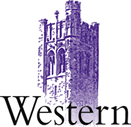 The
UNIVERSITY of WESTERN ONTARIO
The
UNIVERSITY of WESTERN ONTARIO
Faculty of Information and Media Studies
LIS 514 - Academic Libraries
Winter 2003
 The
UNIVERSITY of WESTERN ONTARIO
The
UNIVERSITY of WESTERN ONTARIO
LIS 514 - Academic Libraries
Winter 2003
GROUP PRESENTATIONS
Process
Working in partnership with 3 or 4 colleagues, each student is required to be participate in a group presentation on a topic provided by the course instructor. Members of the group should consider themselves seminar leaders, there to provide leadership, elicit comments and questions, and encourage contributions from the class derived from their previous experience and background reading.
Presentations should be as interesting and informative as possible, using media and working examples as appropriate. Plan for a maximum of10 minutes per person, plus time for discussion.
Other class members are expected to have read about the topic and to participate actively in the seminar.
Documentation
One week prior to a presentation, the group should distribute to the class and to the instructor a short annotated bibliography of key readings that should include some new references that do not already appear on the course handout.
At the end of the class, the group should submit to the instructor an outline of the presentation in point form with scope notes, and any appropriate illustrative material.
Evaluation
The presentation represents 30 percent of course requirements. Evaluation will be based on class presentations, including the content, the coordination of efforts among group members, presentation style, degree of audience participation, the pertinence of the selected bibliography, the clarity, organization and analytical aspects of the written outline, and time management. The grade assigned will be a combination of a group mark - 50 % for bibliography, coordination of efforts, written outline, audience participation - and an individual mark - 50 % for content, presentation style, time management, audience participation.
Topics
30 January: Strategic Planning
Create a strategic plan for an academic library. Set the institutional and library contexts in terms of size (programs, students), resources (human, financial) and other parameters that you judge significant. Create a vision and a mission statement, identify the five top priorities for the next five years, and set goals and priorities related to these goals. Establish a time line for action to achieve the goals and to fulfill the library's mission. Indicate how you will measure success of your strategic plan.
6 February: Collection Development in a Digital World
Collection development in academic libraries has changed and continues to change due to the influence of an increasingly electronic environment. Describe alternatives to local print collections that academic libraries are exploring. Address e-journals and e-books, resource sharing, document delivery, consortial purchases, electronic access, etc. One relatively new option that is widely debated in the literature is the "Big Deal"; examine its pros and cons, and speculate on its future. What impact do these collection alternatives have on collection development procedures, use of library space, circulation, reference and instruction services?
6 March: The College Library
Compare and contrast the mandates of college and university libraries. Examine their user populations, resources, services, technology, programs. Elaborate on the role of librarian in each type of library. Describe the education and professional development programs that should be in place to prepare academic librarians for their position responsibilities in the respective institutions.
13 March: Information Technology
The university library of the early 21st century is a complex
environment technologically. Describe the hardware, software, networks
and general connectivity typical of an academic library. What is the impact
of technology on library operations and services? How are decisions reached
in a world characterized by constant change and multiple choices? How can
library staff and customers survive and even thrive in the academic library
immersed in technology?
27 March : Performance Measures and Indicators
Examine the library indicators used in the Maclean's university rankings and the ARL Statistics. Point out trends in university libraries as revealed by the figures presented over the years. Discuss the validity and usefulness of these indicators for measuring the quality and effectiveness of academic libraries. Propose additional or alternate performance measures and indicators to capture changing practices and patterns in library collections, access and services.
10 April: The Library of the Future
Envision the academic library of the future (2025). What will it look like? Feel like? What will be its focus in terms of collections, services, technology, programs, customers? How alike and how different will it be in comparison with the academic library of 2003? To add a touch of reality, critique the predictions of the past about today's academic library.